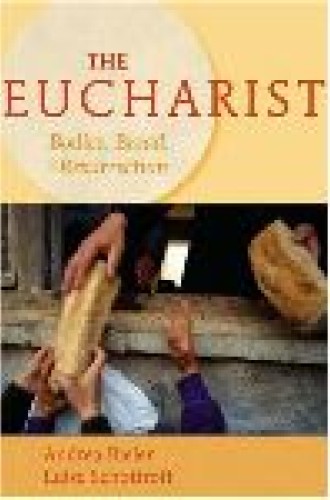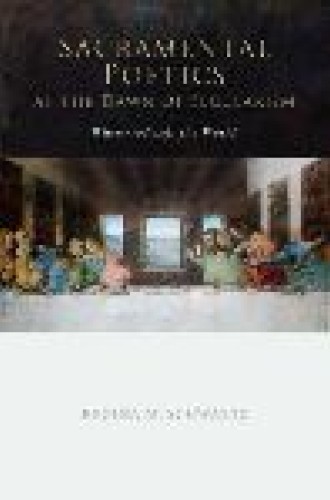Sacramental Poetics at the Dawn of Secularism/The Eucharist
These two books have in common only the fact that they are concerned with the Eucharist; other than that they are written from very different perspectives and go in very different directions. These authors recognize that we are not yet finished with interpreting and enacting the Eucharist. They sense the urgency of the question of eucharistic presence in a flattened, technological world that has almost nothing left of the art of the sacramental.
Regina Schwartz begins with a telling premise: “The Eucharist is a rich site for investigation about the infusion of sacramentality into the secular world.” That matter of infusion is why it is so important to get it right about the Eucharist—and why the church so often struggles to get it right. In an earlier book, her disturbing and important The Curse of Cain, Schwartz reflects on the conviction that monotheism in principle is a lethal enterprise that perforce produces exclusionary practices around race, ethnicity and gender. In the present book, she returns to Christian monotheism to consider from a Jewish perspective what the defining sacrament of Eucharist might mean in its theological claim and in its actual performance.
In two shrewd chapters Schwartz sets up her study of sacramental practice, offering a knowing reflection on the theological concerns of the Reformers and their rejection of the doctrine of transubstantiation. It is that rejection and loss to which she refers in her subtitle, “When God Left the World.” She approaches her examination of the problem from two perspectives. On the one hand, she contends that the Reformation denied the full mystery of the Eucharist that was carried by transubstantiation: “Reformers chipped away at sacramentality until the body of sacramental experience was reduced beyond recognition, and, for some, this meant that God might be leaving the world—yet once more.” She connects this Reformation decision with the rise of modern secularity, but she does not go the whole way with secularity because she judges that the act of sacrament continues to attest to a surplus of meaning in the world. Thus the struggle of the Refor mation continues to be a struggle that must concern those who participate in secularity but refuse it as an ultimate ism.
On the other hand, Schwartz acutely discerns the way in which the pre-Reformation church distorted, politicized and absolutized the Eucharist into authority, so much so that something had to give. She sees that in the power-grasping era of the medieval church, theological discourse appropriated to itself the language of mystery that belonged to the Eucharist, so that “mystical poetry” descended to “the depths of practical politics.”
Given the requirement of change from the medieval synthesis and given the Reformation’s response, Schwartz’s study is devoted to the way in which Reformation and post-Reformation poets probed the eucharistic mystery. She considers four poets in turn:
I would prefer to express it as hope instead of as loss. Justice [Shake speare], a life-world [Milton], love [Donne] and conversation [Herbert]—the departure of these eucharistic impulses would be very much worth lamenting, and these poets offer a reminder of their value as well as the hope that we will continue to desire these and strive for them—however sadly.
With reference to the sacrament, Schwartz’s case for Shakespeare is the least effective of the four. But her discussions of the other poets merit attention. She judges that what we see exhibited in their great poetry is not real presence but real hunger. And it is that real hunger that still persists and that summons the church to more effective thought and testimony—and, no doubt, that in skewed ways feeds unhealthy political discussion in the church.
It appears to me that Schwartz, as an outsider to Christian faith, has accepted Roman Catholic transubstantiation as the baseline for her experiment and perhaps is unwilling to engage the eucharistic thought and practice of the Reformation in any way except by regarding it as a deficit. But her judgment as an outsider does indicate that the quarrels over presence constitute an important summons to those who care about palpably authentic embodied faith.
The Eucharist moves in a very different direction. Whereas Schwartz offers a historical study with contemporary implications, Andrea Bieler and Luise Schottroff directly face the contemporary quotidian reality of the sacrament in its tactile potential. The book takes the Eucharist as a “resurrection meal” and frames the discussion around “sacramental permeability” concerning the ambiguous relationship between this “Holy Eating” and “ordinary meals,” both of which, in different ways, are sacramental.
This study is an act of practical theology that reflects on the way we eat, the way we regard food and the palpable way in which food mediates life. The peculiarity of the eucharistic meal is realized through eschatological imagination wherein the eaters anticipate the new covenant and the coming of the economy of God into the world. The capacity of such imagination is the readiness “to see one thing as another,” with the accent on “as,” the “copula of imagination” to Garrett Green. The “other world” that is imagined in this Holy Eating is not an escape into “otherworldliness,” but is access to a world governed by the Messiah through the promises of God. Bieler and Schottroff urgently argue that the Eucharist has been preempted and redefined in dualistic thinking that leaves the status quo of the world untouched, so congregations can take the meal without raising questions of violence; the outcome is a “colonized imagination” that is drained of dangerous hope.
In their narrative account, I find most helpful and compelling their presentation of “the Bread of Life” in two economies: the economy of the market and the economy of grace (a theme also explored by Douglas Meeks and Miroslav Volf). On the one hand, there is the culture of obesity, diets, eating disorders and exercise programs; on the other hand, as attested by the New Testament, there is a hunger and a feeding whereby broken bread makes whole. The authors draw out the centrality of commodity in the wake of Adam Smith, but they also show that authentic Eucharist is an act of giving and receiving gifts in gratitude and generosity, an act that culminates in a manna economy of abundance that contradicts the market thesis of scarcity. Because the eucharistic meal does not exist in a zone apart from real life, the authors suggest a “parallel between the kitchen table and the altar,” a parallel that is powerfully present in John Everett Millais’s sketch The Leaven (1864). The picture shows a woman kneading bread in the midst of a simple kitchen where, clearly, meals are regularly prepared.
From this analysis of the table of resurrection and eschatological hope, the authors draw concrete and radical political conclusions: “The Eucharist is the feast of radical empathy with the most vulnerable.” As a result of this understanding, the Eucharist attests to the presence of the body in the bread, even if in ways that are not very clear. (On “not very clear,” see Schwartz.) The authors of The Eucharist reflect on the body of believers who eat the bread, who tell the “body story,” who have “social power struggles . . . inscribed in our bodies, our skin, our genitals.” Thus the meal becomes a venue for the processing of bodily pain that is enacted by the state (in torture) or by the demands of the market, and for the transformation of that pain as believers eat the resurrection in hope. This book moves in a quite practical way, offering some art and poetry to make points that will not be well made in straight-line prose—an offer that I find quite compelling.
In a happenstance way, these books complement each other. Bieler and Schottroff do not linger long over the liturgical mystery but take the bread as a parable about bodily life in the world; conversely, the public dimension of the meal is absent in Schwartz, perhaps because of the normative role assigned to transubstantiation. The historical study of Schwartz and the practical theology of Bieler and Schottroff are incommensurate. Together they invite a sustained, thoughtful probing into sacramentality that is most generous but that focuses on real people eating real bread in a real community as a subversive act that offers an alternative world. It could be, after our rigorous theology and our disciplined ethics, that it is liturgical participation that matters most—a point that the authors of both books appreciate.
It is good to talk at meals, but getting bread that nourishes counts first. Secular, imperial society practices an amnesia in which neither pain nor praise is effectively rendered. Schwartz sees that “the gods are ever-departing; hence they are ever-returning only to depart again.” The meal does not last long, but it is offered repeatedly. When the feast is celebrated again, a new world is given. If we take the poetry offered by Schwartz and the bread kneaded by Bieler and Schottroff, we have what we need: word and sacrament, enough to frame a new life. These books will set any careful reader in a new direction.






